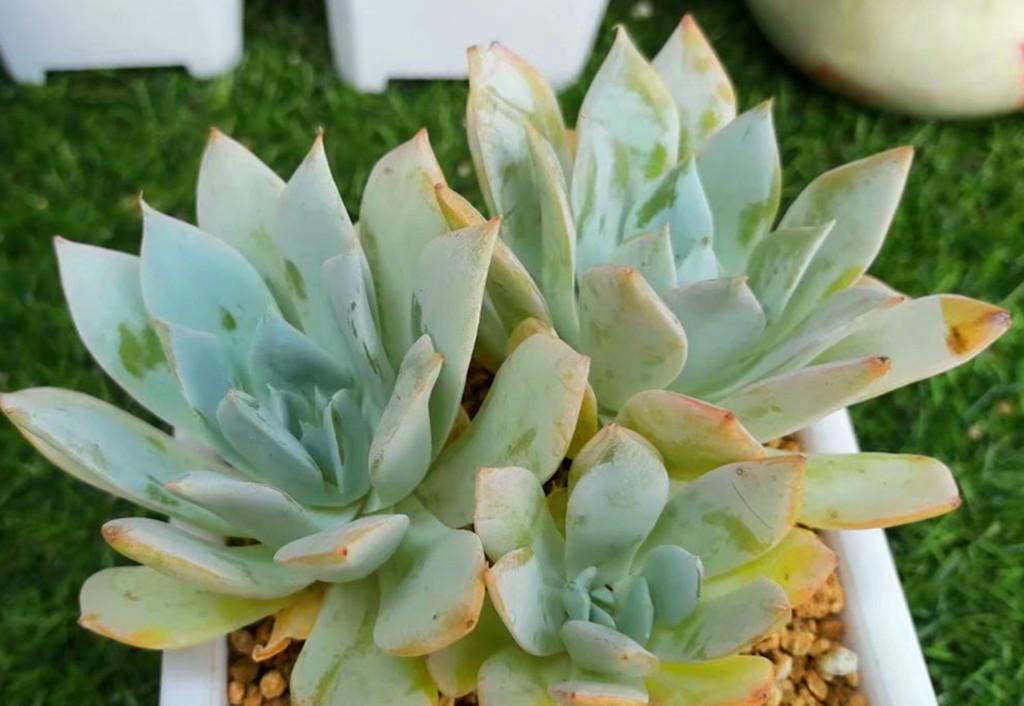Hello everyone, here is the garden with the poems, I am spring. Pink blue bird is a succulent species that meat lovers like very much, but the succulent called blue bird is not only the pink blue bird, but also the thin leaf blue bird, etc. The thin leaf blue bird not only looks different from the pink blue bird, the price and the degree of good breeding are also different. Plants of the same size, the pink blue bird is generally more expensive than the thin-leaved bluebird, the thin-leaved bluebird has no obvious dormancy period in summer, and the pink-bluebird may be semi-dormant or dormant at high temperatures. Some novice meat lovers can't figure out the difference between these two bluebirds and often buy them wrong.

Thin-leaved bluebird
For the origin of the thin-leaf bluebird, there are different theories, there is a saying that the thin-leaf bluebird is a variant of the Pi's stone lotus, and some say that the thin-leaf bluebird is a hybrid of the Guanghan Palace and the bluestone lotus, the specific origin is really not easy to draw conclusions, but it is certain that the thin-leaf bluebird and the pink bluebird are easy to distinguish, it can be said that it is clear at a glance, novice meat friends must not see the bluebird and think that it is the kind of out of the state can become pink toot. The fleshy pink blue bird, because the thin-leaved bluebird is mostly blue-white or blue-gray in color, the outer leaves may be a little orange-yellow or pink-orange, much thinner than the leaves of the pink-blue bird.
Pink blue bird
Pink blue bird is also a species of unknown origin, it is said that the pink blue bird is a hybrid of corolla and blue stone lotus, the leaves of the pink blue bird are much thicker than the thin leaf blue bird, the leaf type is different, the state of the pink blue bird leaves will have obvious dark lines, the color is also pink. The pink blue bird raised in spring has even appeared all pink in the season when the temperature difference is large in sufficient light.
Thin-leaved bluebird summer is relatively easy, there is no too obvious dormancy period, but thin-leaved bluebird summer does not like sun exposure, pink bluebird in the high temperature of more than thirty degrees, it is possible to enter the semi-dormant stage, pink bluebird is also very afraid of exposure, temperature above twenty-five degrees, as long as the ultraviolet rays are strong, it is easy to sunburn the leaves of the pink bluebird. Although the thin-leaved bluebird and the pink bluebird do not like the summer sun exposure, but they like the spring and autumn and winter sufficient and warm light, if the lack of light for a long time, the leaves of the thin-leaved bluebird will turn green, and the pink bluebird is particularly easy to grow.
Thin-leaved bluebird and pink bluebird leaves have white powder, after the rain the leaves will become ugly, but it is also easier to recover, thin-leaf bluebird is more resistant to rain than pink bluebird, because the probability of rain black rot is smaller than that of pink bluebird, thin-leaf bluebird also prefers water than pink bluebird, do not need excessive control, because thin-leaf bluebird leaves are larger and more beautiful, thin-leaf bluebird lack of water can generally be seen from the leaves, and the thin-leaved bluebird is thin or wrinkled to prove that the thin-leaf bluebird lacks water.
Pink blue bird needs more granular control plus appropriate water control, in order to appear a better state, especially in the summer high temperature, the leaves are wrapped up when a small amount of water can be, low temperature growth is slow to control watering, but the spring and autumn vigorous growth period can not be overly controlled water, lack of water will make the plant longer and smaller.
Thin leaf bluebird is easy to group or headshot, pink blue bird headshot has a certain degree of difficulty, there is a pot of pink blue bird in the spring, raised for two or three years without headshots, although the headshot is difficult, but it is not recommended that meat friends behead the pink blue bird, because the large single head pink blue bird is also very beautiful, and the single head pink blue bird is evenly lighted, and it is more likely to appear in the ultimate state. If the beheading is not successful, the originally beautiful big single head will become ugly.
Thin-leaved bluebird and pink bluebird can be leaf cuttings in principle, but thin-leaved bluebird leaf cuttings are easy to turn into water, generally using decapitation cuttings to propagate, pink blue bird leaf cuttings survival rate is OK, but the leaves of the pink blue bird are not easy to pick down, meat friends in the pink bluebird leaves, must pay attention not to destroy the bud point, because the bud point destroys the pink blue bird leaf is difficult to succeed in leaf cuttings.
What do you think is the difference between a thin-leaved bluebird and a pink bluebird, and how should they be cared for? Feel free to leave a message below to share.
This article is original by [Garden and Poetry], please do not reprint without permission, plagiarism is strictly prohibited, thank you.